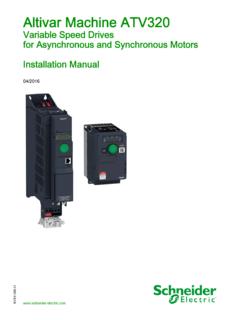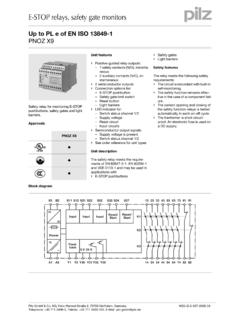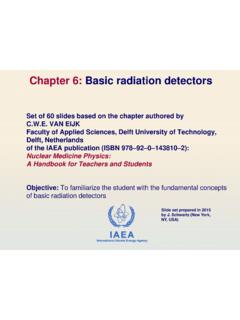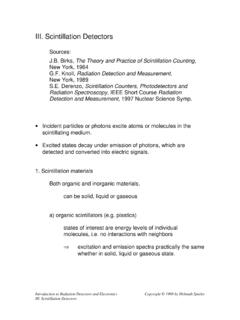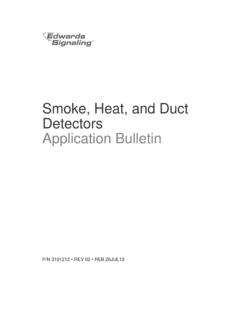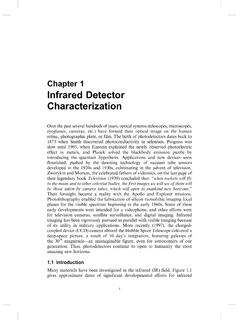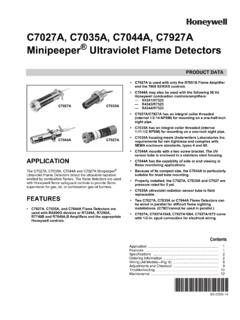Transcription of General Inductive proximity sensors
1 31100 ElectricInductive proximity sensors enable the detection, without contact, of metalobjects at distances of up to 60 range of applications is very extensive and includes : the monitoring ofmachine parts (cams, mechanical stops, etc.), monitoring the flow of metalparts, counting, etc. Inductive proximity sensors are solely for the detection of metal basically comprise an oscillator whose windings constitute the alternating magnetic field is generated in front of these of an Inductive proximity sensor1 Oscillator2 Output driver3 Output stageWhen a metal object is placed within the magnetic field generated by thesensor, the resulting currents induced form an additional load and theoscillation ceases. This causes the output driver to operate and, depending on the sensor type,a NO, NC or NO + NC (complementary) output signal is of a metal physical contact with the object to be detected, thus avoiding wear andenabling fragile or freshly painted objects to be operating resistance to industrial environments (robust products, fully encapsulated in resin).
2 / solid state technology : no moving parts, therefore service life of sensorindependent of the number of operating cycles. Presentation123 Inductive proximity sensors enable the detection, without contact, of metalobjects at distances of up to 60 range of applications is very extensive and includes : the monitoring ofmachine parts (cams, mechanical stops, etc.), monitoring the flow of metalparts, counting, etc. Inductive proximity sensors are solely for the detection of metal basically comprise an oscillator whose windings constitute the alternating magnetic field is generated in front of these of an Inductive proximity sensor1 Oscillator2 Output driver3 Output stageWhen a metal object is placed within the magnetic field generated by thesensor, the resulting currents induced form an additional load and theoscillation ceases.
3 This causes the output driver to operate and, depending on the sensor type,a NO, NC or NO + NC (complementary) output signal is of a metal physical contact with the object to be detected, thus avoiding wear andenabling fragile or freshly painted objects to be operating resistance to industrial environments (robust products, fully encapsulated in resin)./ solid state technology : no moving parts, therefore service life of sensorindependent of the number of operating proximity detectionAdvantagesof inductivedetectionPrinciple of operationInductive proximity sensorsObject to be detectedObject to be detected31100 Electric 0,81 SnSn21 Sensing faceHThe operating zone relates to the area in front of the sensing face in whichthe detection of a metal object is certain.
4 The values stated in thecharacteristics relating to the various types of sensor are for steel objects ofa size equal to the sensing face of the sensor. For objects of a differentnature (smaller than the sensing face of the sensor, other metals, etc.), it isnecessary to apply a correction coefficient (see page 31100/14).1 Detection threshold curves2 Object detected LEDN ominal sensing distance (Sn).The rated operating distance forwhich the sensor is designed. Itdoes not take into account any va-riations (manufacturing tolerances,temperature, voltage, etc.).Real sensing distance (Sr).The real sensing distance is measuredat the rated voltage (Un) and at ratedambient temperature (Tn).It must be between 90% and 110% ofthe nominal sensing distance (Sn) Sn Sr sensing distance (Su).
5 The usable sensing distance ismeasured at the limits of the per-missible variations of the ambienttemperature (Ta) and the supplyvoltage (Ub). It must be between90% and 110% of the real sensingdistance (Sr) : Sr Su operating distance (Sa).This is the operating zone of assured operating distance isbetween 0 and 81% of the nominalsensing distance (Sn) : 0 Sa x x mild steel (Fe 360) plate,1 mm side dimension of the plate iseither equal to the diameter of thecircle engraved on the active surfaceof the sensing face or 3 times thenominal sensing distance (Sn).The differential travel (H), or hyste-resis, is the distance between thepick-up point as the standard metaltarget moves towards the sensorand the drop-out point as it repeat accuracy (R) is the repeatability of the usable sensing distancebetween successive operations.
6 Readings are taken over a period of timewhilst the sensor is subjected to voltage and temperature variations :8 hours, 10 to 30 C, Un 5 %. It is expressed as a percentage of proximity sensorsStandard metal targetOperating zoneSensing distancesStandard metal targetDifferential travel Repeat accuracy(Repeatability)Sa=H = course diff rentielleTerminology Su OFFSr max. + HSn + HSu max. + HSr min. + HSu min. + HCertain detectionAssured operatingdistanceSensingdistanceDrop-out pointPick-up pointFrontal approachStandard metal target31100 Electric BUBN /++/ BUBNBUBNBUBKBNPNP+ + BUBKBNNPNBUWH (NC)BK (NO)BNPNP+ + BUBK (NO)WH (NC)BNNPNBKWHBN (NO), BU (NC)BU (NO), BN (NC)BN (NO), BU (NC)BU (NO), BN (NC)PNP+ + WHBKNPNXSXSXSC orresponds to a proximity sensorwhose output (transistor or thyristor)changes to the closed state when anobject is present in the to a proximity sensorwhose output (transistor or thyristor)
7 Changes to the open state when anobject is present in the to a proximity sensorwith 2 complementary outputs, oneof which opens and one of whichcloses when an object is present inthe operating polarity conscious, connectionsto + and against overload andshort-circuit. /Not protected against overload V supply, either " or $./Certain models protected againstoverload and against reverse against overload against reverse against overload against reverse against overload signal(contact logic)2-wire type3-wire type4-wire type,complementary outputs gr4-wire type, multifunction, programmableNONCNO + NCcomplementaryoutputs2-wire $ non polarisedNO or NC output2-wire "NO or NC output2-wire 7NO or NC output3-wire $ NO or NC outputPNP or NPN4-wire $ NO and NCPNP or NPN4-wire $ NO or NC,PNP or NPNG eneralInductive proximity sensorsOutputs and wiring31100 Electric 2-wire connection3-wire connection+ SI+ + SIThese proximity sensors convert theapproach of a metal object towardsthe sensing face into a currentvariation which is proportional to thedistance between the object and thesensing models available :/Dual voltage : $ V /Single voltage.
8 $ 24 V Output 0-16 mA for 3-wireconnection and 4-20 mA for 2-wireconnectionThe proximity sensors conformingto NAMUR (DIN 19234) recommenda-tions are electronic devices whosecurrent consumption is altered by thepresence of a metallic object within thesensing small size makes themsuitable for various applications inmany sectors, notably : /Intrinsically safe /Non intrinsically safe Factory fitted moulded cable, good protection against splashing : machine tool of installation and , cable runs to required characteristics of the various types of output, wiring precautions and terminology, see pages 31100/15 to31100/18. Output 0-10 mA for 3-wire connection, and 4-14 mA for 2-wire connection.(hazardous areas).
9 sensors used with an NY2 intrin-sically safe relay/amplifier or acompatible solid state input whichis suitably approved for intrinsi-cally safe applications.(normal safe areas). sensors used with an XZD powersupply/amplifier unit or a compa-tible (DIN 19234) solid state typeNAMUR typePre-cabledConnectorScrew terminalsSpecific output signalsConnection methodsAdditional information regarding outputsGeneralInductive proximity sensorsOutputs and wiring31100 Electric LED indicators211212121 2 All Telemecanique brand Inductive proximity sensors incorporate an outputstate LED indicator. Output LED function tableCertain block type XS7, XS8, XSD Inductive proximity sensors incorporate asupply LED, in addition to the output provides instant verification of the supply state of the sensor.
10 This LED, complementary to the output LED, flashes in the event of a short-circuit occurring on the load side of the remains in the flashing state until the supply to the sensor is removed andthe short-circuit feature is particularly useful when switching Inductive loads, which areprone to short-circuit LED is incorporated in the following 2-wire type " and $short-circuit protected sensors : 18 mm cylindrical type, 30 mm cylindri-cal type and XSD block type. No object present Object presentShort-circuit Short-circuit LED function tableNO outputNC outputNo object presentLEDO utput stateObject presentLEDO utput stateNO outputNC output1 Output LED2 Short-circuit LEDG eneralOutput LEDS upply LEDS hort-circuit LEDI nductive proximity sensorsSpecific functions31100 Electric Output signal time delay1010 TTtttt1010 TttttBlock type XSC and XSD sensors incorporate a potentiometer adjusted 1 to20 second output time outputs of these sensors are programmable (by links) and any of thefollowing configurations are possible.
